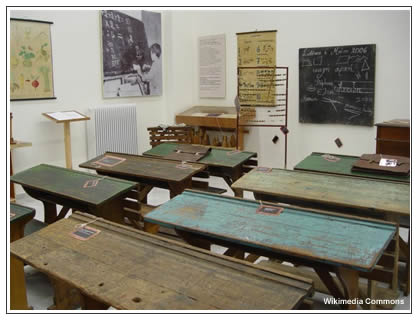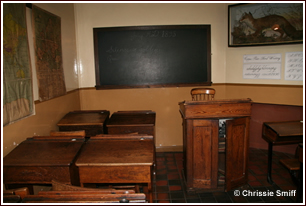The rich have always believed in the value of education and there were schools in England from as early as the 14th Century. These early schools were intended to prepare boys for entry into the universities of Oxford and Cambridge. Education and religion were inextricably tied together for several centuries and schoolmasters were often also clergymen. As the Empire grew boarding schools (for both sexes) were established to cater for the children of those who were serving in the colonies. In the main girls were taught at home by governesses. Lessons in schools were conducted in Latin, the language of the educated classes.

Poor children may have received a little education at Dame Schools, which began in the late 17th century. Dame schools were run by widows or spinsters who took children into their homes and taught them to read and write, for a few coppers a week. A number of charity schools were also founded around this time for the education of the poor. The emphasis in these schools was on morality but the children were taught to read and write and the boys were taught arithmetic, while the girls were taught to knit and sew. Sunday schools were established mainly for the moral education of poor children but they were also sometimes taught elementary skills.
In the 1840s teacher training colleges were established to train teachers for the growing number of charity schools. These catered for men and women. College records show that many trainees came from the lower middle and upper working classes. The pay was very poor and census shows that teachers were often boarders with working class families. Many schools were still understaffed, so in 1846 the pupil-teacher system was established. ‘Morally sound’ and intelligent pupils were apprenticed to teach and after five years could apply for a Queen’s Scholarship to enter a training college. At around the same time colleges were established to provide proper training for governesses as the upper classes began to realise that they should also educate their daughters well.
The Forster Act of 1870 divided the country into 2,500 school districts governed by School Boards who could enforce attendance for five to thirteen year olds. More teachers were needed and more colleges established.
Teaching soon came to be seen as a suitable job for the daughters of the middle classes and colleges and institutions were founded to educate women teachers. So a profession that was once dominated by men was accepting more and more women into its ranks, although women’s’ pay was much lower. Women teachers were expected to retire from teaching when they married, even up to World War Two. During the war women teachers were encouraged back to work and once they had a toehold they refused to let go and the custom of ‘retirement’ on marriage lapsed. The teaching unions fought hard for equal pay and this was granted in 1944.
For several years following the end of the war demobbed soldiers deemed academically able were offered the chance of ‘Emergency Teacher Training’. They were rushed through their training with minimum resources available, but many rose to the office of Head Teacher and others were instrumental in loosening the formality of the classroom and making education more child-centred.
Many 18th and 19th Century authors, notably Dickens and Charlotte Bronte, describe schools and the lives of schoolteachers in their novels. There can be no better source than these for an understanding of what the lives of many school teachers were like. Mostly teachers lived in ‘genteel poverty’. They had some status in the community as members of a ‘profession’, but without the financial rewards enjoyed by other professions such as law and medicine.
Sources for researching schoolteachers

Many public and private schools have staff records dating back to when the school was founded. Many more are deposited in county record offices.
School logbooks are a wonderful resource. They were compiled by the head teacher and describe the daily routine of the school and special events (I am lucky enough to have copies of the entries of the day when my father was interviewed for a position and his first day in the job). In the same log book the head teacher notes, rather crossly, that 22 children were absent for potato picking. He also records the school choir’s success in the local festival of Arts.
School Magazines often have a list of staff members and their responsibilities.
In older schools there may be boards with the names of past head teachers or of teachers and pupils lost in the wars.
Universities have records of former students as do many former teacher training colleges. Those not at the colleges have mainly been deposited in the CRO, although a few have been lost.
Local newspapers often carry school photographs and stories about the school, which will include the names of teachers involved.
Teachers’ Union records have been carefully preserved. Many records of the executive of the NUT are held at Warwick University’s Modern Records centre but there are other teachers’ union records in CROs.
Guinevere
© Guinevere 2008